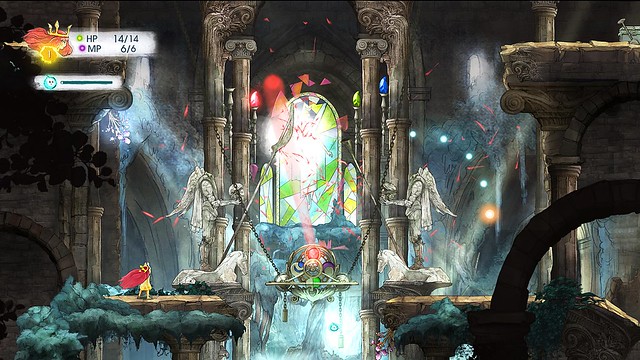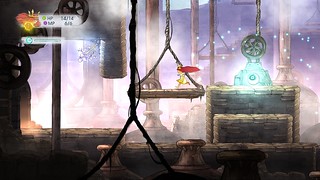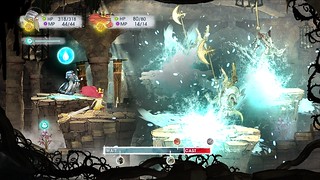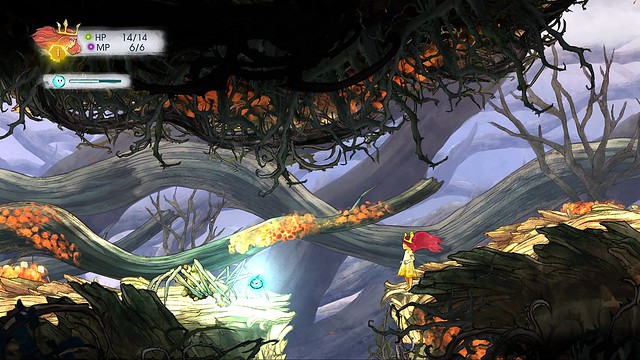
Before a crumbling statue in a dark wood, Aurora faces her first enemy in Child of Light. As it screeches in the little girls’ direction, she hefts her oversized sword into the air with supreme confidence. She’s unfazed by its arachnid frame and menacing gait. This encounter depicts Child of Light in its purest form: unflinching, beautiful, and defiant of expectations. It’s a PS3 and PS4 RPG that celebrates the RPG tradition while striking out on a new path, wholly its own.
When I first wrote about Child of Light last year, Aurora had already embarked on her adventure through the enchanting world of Lemuria. Earlier this week, I had the opportunity to play the opening two hours, uninterrupted. The result: an unassailable emotional connection to Aurora and her quest. The team at Ubisoft Montreal has crafted a heart-rending story, steeped in detail and welcoming to young gamers as well as old.
Aurora’s arrival in Lemuria is immediately tragic. Daughter to an Austrian duke, the young girl falls ill and wakes in an unfamiliar wood. Bereft of her father and overwhelmed with emotion, Aurora is soon united with a charming little flame, Igniculus, whom Aurora addresses as “Sir Firefly.” He guides her to a seer and mystic who could reveal her pathway home.


But adventures are rarely so easy, and Aurora is tasked with finding the Sun, Moon, and Stars, which have been stolen from the sky by the Black Queen. Returning the light to the land may enable Aurora to go home and be with her family again, so she is forced to play the role of hero.
Unlike many JRPG leads, Aurora embraces her newfound quest with startling haste. She charges forward with no trace of childlike fear or hesitance — a refreshing change from the norm. And while Child of Light features turn-based battles and questing companions, it more often than not darts away from RPG stereotypes, or finds clever ways to invigorate them.
If the above art hasn’t conveyed the point, Child of Light boasts a rare sort of beauty, equal parts ethereal and familiar. The UbiArt Framework makes each scene and each character look marvelous, from lamenting specters to gilded walls. The layered backgrounds give each environment immense depth, with birds taking flight and the silhouette of a giant lumbering past in the distance.

Every word in Child of Light, from the narration to the dialogue (even the quest objectives), is written in varying forms of rhyme. This bestows Child of Light with a storybook quality — though it maintains an abundance of wit. Aurora and Igniculus, for example, recruit a jester into their party that simply can’t seem to rhyme, and the pair must cooperatively correct her mistakes.
These clever plays with words are not all comical. When passing a cemetery, Igniculus remarks: “Don’t they know? Rocks planted in the ground will not grow.” A heart-breaking vignette of the firefly’s innocence and naivety, laid atop an unsettling background.
With no spoken dialogue outside of the unseen narrator, Child of Light’s aural spell is cast with exquisite music. The audio team employs long, running piano melodies rife with heart. They stir up in rhythm with Aurora’s journey, haunting the player with sparse chords or building tension with tumbling solos. It invokes Yann Tiersen’s immaculate work with the Amelie soundtrack in 2001 (Child of Light Creative Director Patrick Plourde mentioned the film to me when we first met, so it’s been on the mind…).
The more time players spend with Child of Light’s battle system, the more intricacies are revealed. Though the system itself is a straightforward, turn-based platform, the finesse involved with timing goes far deeper. There’s an art in waiting for the right moment to strike, interrupting an enemy attack and keeping Aurora safe. Igniculus can shine in the faces of enemies and delay their turn, allowing for further control of the flow of battle. Another player, be it a child, sibling, or partner, can control Igniculus on a second DualShock and take a simpler (but no less strategic) role.
Earning levels grants skill points to Aurora and her companions, which can be spent to unlock additional abilities in a branching skill system. Earning new skills makes the next in the branch available, giving players some flexibility in how they develop each hero.

And through it all, the player builds a connection with Aurora, who’s just about the most charming RPG hero in recent memory. This emotional resonance, coupled with the rich writing, promise to bring players back time and time again for repeat play sessions for years to come.
Related Posts:
- Child of Light - writer interview - GoNintendo
- Child of Light - new gameplay details - GoNintendo
- Child of Light rhymes fairy tale charms with JRPG arms - joystiq
- Child of Light: Ubisoft's Secret JRPG Weapon - IGN
